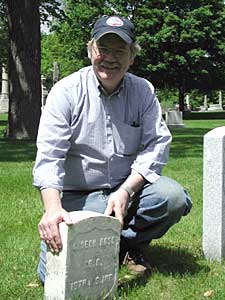|
Audio
Photos
Resources
|
May 29, 2005
 |
| Amateur historian Pat Hill gives guided tours of Civil War veterans buried at Oakland Cemetery in St. Paul. (MPR photo/Cathy Wurzer) |
St. Paul, Minn. — Alexander Ramsey, the first territorial governor of Minnesota and the state's second governor, is buried in Oakland Cemetery.
He was in Washington, D.C. when Fort Sumter was captured by Confederate forces in 1861, and became the first governor to offer state troops to President Lincoln. Those troops would become known as the First Minnesota Volunteer Infantry Regiment, and fight in several key Civil War battles.
About 25 feet from Ramsey's grave, you'll find the grave of Henry Sibley, the first governor of the state of Minnesota. Unlike Ramsey's granite monument, which shows little signs of wear, Sibley's marble monument has deteriorated greatly with time.
Sibley, a Democrat, narrowly defeated Ramsey, who was a Republican, to become governor in 1858. Despite being political rivals, Ramsey and Sibley were close personal friends. Ramsey lived with Sibley in Mendota for a time when Ramsey first moved to the Minnesota territory.
The second territorial governor of Minnesota, Willis Gorman, is also buried at Oakland Cemetery.
Gov. Ramsey made Gorman a colonel in the First Minnesota Volunteer Infantry Regiment. He fought in the Battle of Bull Run and led his troops at Antietam. Ramsey became a brigadier general in October of 1861.
Civil War survivors organized Minnesota's first Memorial Day observance, or Decoration Day as it was known, at Oakland Cemetery in 1870. The graves of 60 Civil War veterans were decorated during that Memorial Day. Within 50 years they were decorating 800 graves.
Oakland Cemetery is also "the people's cemetery." Many new immigrant families who bought multiple plots in the 19th century, did not use all their allotted gravesites.
In recent years, many of those unused burial plots have been purchased by the families of Hmong immigrants, creating a mixure of new and old immigrant gravesites.
To listen to Pat Hill's interview with MPR's Cathy Wurzer, choose the audio link in the right column.







